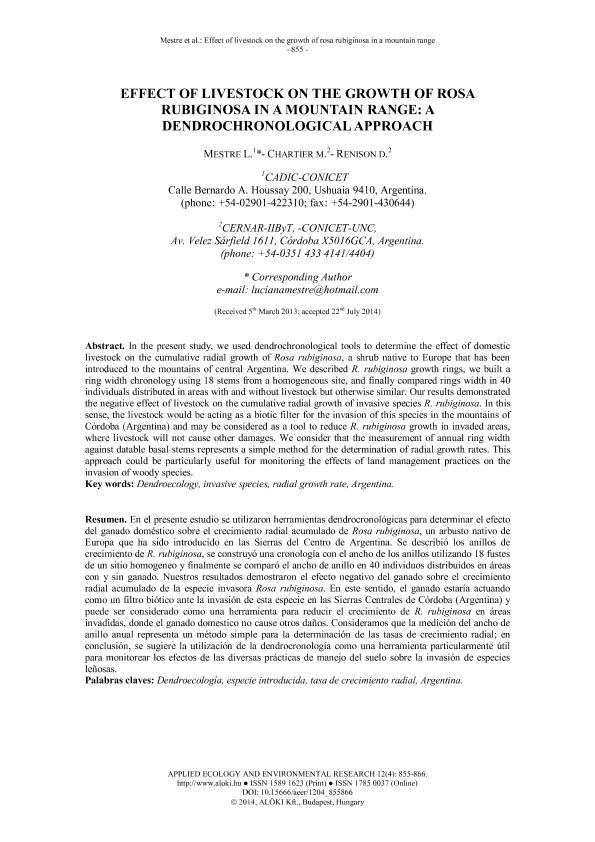Mostrar el registro sencillo del ítem
dc.contributor.author
Mestre, Luciana Mariel

dc.contributor.author
Chartier, Marcelo Pablo

dc.contributor.author
Renison, Daniel

dc.date.available
2018-03-28T13:20:06Z
dc.date.issued
2014-06
dc.identifier.citation
Mestre, Luciana Mariel; Chartier, Marcelo Pablo; Renison, Daniel; Effect of livestock on the growth of Rosa rubiginosa in a mountain range: A dendrochronological approach; Corvinus Univ Budapest; Applied Ecology And Environmental Research; 12; 4; 6-2014; 855-866
dc.identifier.issn
1589-1623
dc.identifier.uri
http://hdl.handle.net/11336/40340
dc.description.abstract
In the present study, we used dendrochronological tools to determine the effect of domestic livestock on the cumulative radial growth of Rosa rubiginosa, a shrub native to Europe that has been introduced to the mountains of central Argentina. We described R. rubiginosa growth rings, we built a ring width chronology using 18 stems from a homogeneous site, and finally compared rings width in 40 individuals distributed in areas with and without livestock but otherwise similar. Our results demonstrated the negative effect of livestock on the cumulative radial growth of invasive species R. rubiginosa. In this sense, the livestock would be acting as a biotic filter for the invasion of this species in the mountains of Córdoba (Argentina) and may be considered as a tool to reduce R. rubiginosa growth in invaded areas, where livestock will not cause other damages. We consider that the measurement of annual ring width against datable basal stems represents a simple method for the determination of radial growth rates. This approach could be particularly useful for monitoring the effects of land management practices on the invasion of woody species. © 2014, ALÖKI Kft., Budapest, Hungary.
dc.description.abstract
En el presente estudio se utilizaron herramientas dendrocronológicas para determinar el efecto del ganado doméstico sobre el crecimiento radial acumulado de Rosa rubiginosa, un arbusto nativo de Europa que ha sido introducido en las Sierras del Centro de Argentina. Se describió los anillos de crecimiento de R. rubiginosa, se construyó una cronología con el ancho de los anillos utilizando 18 fustes de un sitio homogeneo y finalmente se comparó el ancho de anillo en 40 individuos distribuidos en áreas con y sin ganado. Nuestros resultados demostraron el efecto negativo del ganado sobre el crecimiento radial acumulado de la especie invasora Rosa rubiginosa. En este sentido, el ganado estaría actuando como un filtro biótico ante la invasión de esta especie en las Sierras Centrales de Córdoba (Argentina) y puede ser considerado como una herramienta para reducir el crecimiento de R. rubiginosa en áreas invadidas, donde el ganado domestico no cause otros daños. Consideramos que la medición del ancho de anillo anual representa un método simple para la determinación de las tasas de crecimiento radial; en conclusión, se sugiere la utilización de la dendrocronología como una herramienta particularmente útil para monitorear los efectos de las diversas prácticas de manejo del suelo sobre la invasión de especies leñosas.
dc.format
application/pdf
dc.language.iso
eng
dc.publisher
Corvinus Univ Budapest

dc.rights
info:eu-repo/semantics/openAccess
dc.rights.uri
https://creativecommons.org/licenses/by-nc-sa/2.5/ar/
dc.subject
Argentina
dc.subject
Dendroecology
dc.subject
Invasive Species
dc.subject
Radial Growth Rate
dc.subject.classification
Otras Ciencias Biológicas

dc.subject.classification
Ciencias Biológicas

dc.subject.classification
CIENCIAS NATURALES Y EXACTAS

dc.title
Effect of livestock on the growth of Rosa rubiginosa in a mountain range: A dendrochronological approach
dc.type
info:eu-repo/semantics/article
dc.type
info:ar-repo/semantics/artículo
dc.type
info:eu-repo/semantics/publishedVersion
dc.date.updated
2018-01-03T20:09:53Z
dc.identifier.eissn
1785-0037
dc.journal.volume
12
dc.journal.number
4
dc.journal.pagination
855-866
dc.journal.pais
Hungría

dc.journal.ciudad
Budapest
dc.description.fil
Fil: Mestre, Luciana Mariel. Consejo Nacional de Investigaciones Científicas y Técnicas. Centro Austral de Investigaciones Científicas; Argentina
dc.description.fil
Fil: Chartier, Marcelo Pablo. Consejo Nacional de Investigaciones Científicas y Técnicas. Centro Científico Tecnológico Conicet - Córdoba. Instituto de Investigaciones Biológicas y Tecnológicas. Universidad Nacional de Córdoba. Facultad de Ciencias Exactas, Físicas y Naturales. Instituto de Investigaciones Biológicas y Tecnológicas; Argentina. Universidad Nacional de Córdoba. Facultad de Ciencias Exactas, Físicas y Naturales. Centro de Ecología y Recursos Naturales Renovables; Argentina
dc.description.fil
Fil: Renison, Daniel. Consejo Nacional de Investigaciones Científicas y Técnicas. Centro Científico Tecnológico Conicet - Córdoba. Instituto de Investigaciones Biológicas y Tecnológicas. Universidad Nacional de Córdoba. Facultad de Ciencias Exactas, Físicas y Naturales. Instituto de Investigaciones Biológicas y Tecnológicas; Argentina
dc.journal.title
Applied Ecology And Environmental Research

dc.relation.alternativeid
info:eu-repo/semantics/altIdentifier/url/http://www.aloki.hu/indvol12_4.htm
dc.relation.alternativeid
info:eu-repo/semantics/altIdentifier/doi/http://dx.doi.org/10.15666/aeer/1204_855866
Archivos asociados
